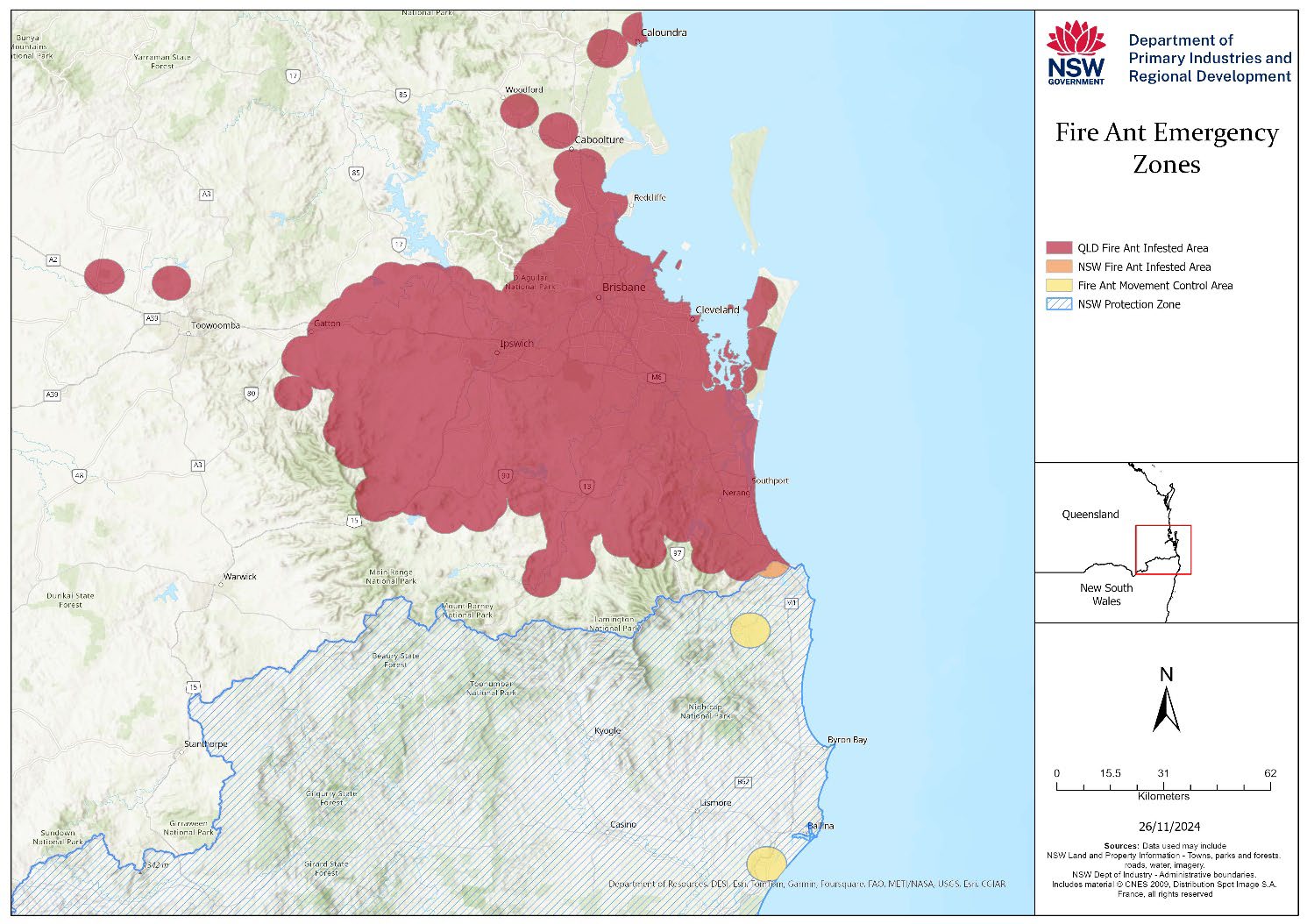Biosecurity (fire ant) Emergency Order (No. 1) 2025:
NSW Department of Primary Industries and Regional Development (the Department) has published Biosecurity (Fire Ant) Emergency Order (No. 2) 2025 on 13 February 2025. This supersedes Biosecurity (Fire Ant) Emergency Order (No. 1) 2025, published on 28 January 2025.
- View the new order and Plain English Guide.
- The Biosecurity Emergency has been extended for a further six months. This acknowledges that there is still a very real risk of fire ants moving into and establishing in NSW and allows NSW DPIRD to remain focused on prevention, surveillance and tracing to address this risk. The extension also allows investigations into the Clunes interception, and subsequent turf suspension, to be continued.
- There are no changes to the carrier requirements in the current order.
- There are no changes to the boundaries of the NSW Fire Ant Infested Area or the Fire Ant Movement Control Areas (Murwillumbah and Wardell). There are no changes to the boundaries of the Qld Fire Ant Infested Area.
On 24 November 2023 fire ants (Solenopsis invicta) were found in South Murwillumbah in north-eastern NSW, 13 kilometres south of the Queensland border.
National Fire Ant Eradication Plan (NFAEP) teams, NSW DPIRD and Tweed Shire Council are working together to eradicate the infestation.
The NFAEP has completed the first of several broadscale treatments in the 5 km area around the nests.
The locations at highest risk of fire ant infestation have been checked, but it’s important for everyone to keep checking for fire ant nests.
UPDATE: On 9 May 2024, a new, immature fire ant nest was located at the original South Murwillumbah infested premises. The nest was assessed as low-risk, and swiftly destroyed by the NFAEP.
Communities in the border regions of Northern NSW should be on the lookout for fire ants and their nests and contact NSW DPIRD or call 1800 680 244 if suspected fire ants are found.
Next steps of the response
The National Fire Ant Eradication Program (NFAEP) will be conducting further surveillance and treatment in the 5km radius around the infestation for up to two years, to ensure there are no more fire ants present.
It is vital that fire 100% of properties in the target area are checked and treated, whether fire ants are visible or not, to protect residents and businesses in the local community from the harmful impacts of this invasive pest.
Murwillumbah residents are being urged to play an active role in protecting their community against fire ants, by providing consent to allow surveillance and treatment on their properties.
When fire ant teams seek access to your property, let them in to keep fire ants out. Authorise fire ant teams to enter the outdoor areas of your property to undertake surveillance and treatment by signing the Property Information Form.
Treatment is safe for people and animals.
Authorise fire ant teams to enter your property
When fire ant teams seek access to your property, let them in to keep fire ants out.
Treatments are safe for people and animals
Treatment is approved by the Australian Pesticide and Veterinary Medicines Authority (APVMA).
What can you do?
- Check your property for fire ant nests and call us if you find any suspicious ants or nests
- Only move products that are regulated as fire ant carriers if allowed by the Emergency Order and the Group Biosecurity Emergency Permit
You're allowed to move fire ant carriers into and within the 5km fire ant movement control area without restrictions.
If you are moving fire ant carriers out of the fire ant movement control area in South Murwillumbah (see Part 2 of the Emergency Order and the Group Biosecurity Emergency Permit):
- Check the definition of your carrier material (Part 1, Clause 9 of the Order)
- Check whether the material has always been kept in preventative conditions (Part 1 Clause 10 for the meaning of preventative conditions, Part 2 of the Order and the Group Biosecurity Emergency Permit for carrier specific requirements)
- If it hasn’t been kept in preventative conditions, ensure that it meets treatment or cleaning requirements (Clauses 16-33)
- Complete a Record of Movement declaration if you are moving fire ant carriers on behalf of a business, organisation or council (Part 2, Clause 12).
Treating or cleaning requirements
Follow the treatment and/or cleaning requirements specified for your carrier in Part 2 of the Emergency Order and the Group Biosecurity Emergency Permit.
Complete the record of movement declaration form
- You must make a Record of Movement (RoM) declaration if you are acting on behalf of a business, organisation or council, and retain these records for 4 years.
- Record of movement (RoM) declarations are not required for agricultural and horticultural equipment, heavy vehicles, pallets, packaging, containers and coverings, green waste, building waste, soil samples, rocks and stones over 20 mm in diameter, recycled concrete aggregate over 20 mm in diameter, and indoor potted plants.
Green bin/organic waste collection by council
- No action is required for grass, vegetation and clippings which are collected by council as part of the council’s waste management services.
Call the Biosecurity Helpline on 1800 680 244 if you need more information.


